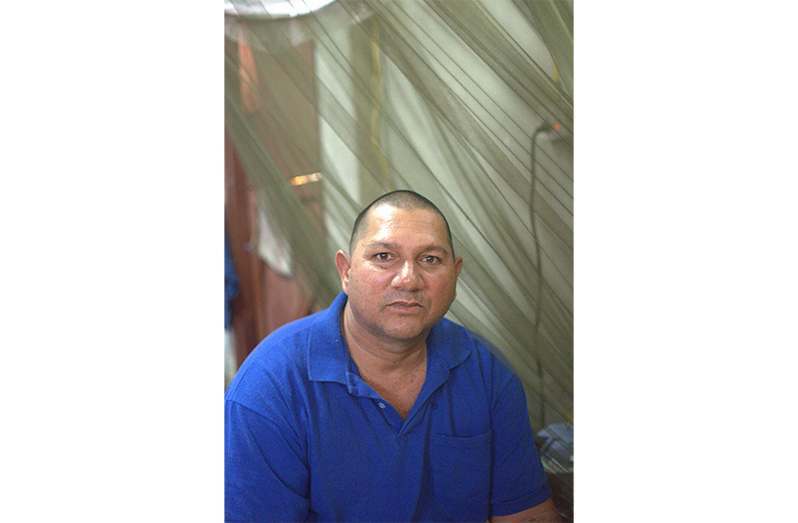Despite paralysis, one man embraces life with courage
DESPITE more than a decade of living without the use of his legs, 50-year-old Tamesh Rambarran greets each day with bold optimism that refuses to fade. His life changed in an instant after a 2014 accident left him paralysed from the waist down, yet the man who once cut cane in the fields of Canal No. 1 has never stopped pushing forward.
The journey has been painful, slow, and often isolating, filled with long nights of discomfort, moments of doubt, and the ache of missing the life he knew. But beneath those challenges is remarkable perseverance. Tamesh has relearned how to move, how to manage, and ultimately, how to live again. Even now, after years of therapy and setbacks, he holds onto a simple but powerful hope: that one day he will rise, stand, and walk on his own once more.
Tamesh, or Tom as he is more commonly known throughout his community, was born and raised in Canal No. 1, a farming village located on the West Bank of Demerara in Region Three. His upbringing was similar to that of most Guyanese, with his early years marked by time spent outside with his siblings, exploring and playing in the Guyanese sun.
Like most men in his community, Tom went into farming at a young age. Not a lover of school, Tom ventured into cane cutting to support his family. “I grew up with my sisters and my other brother; I was the smallest,” he said. “I did not go to school much. My mother died young, so I did not get to go to school. I went into farming.”
Tom found his calling in agriculture, going from cutting cane to farming, and eventually venturing into cattle rearing on his own. “I used to do plenty of farming, cut cane, and then I had my own cows. I liked farming,” he shared. Tom worked in agriculture to support his family. “I have a family, two daughters and one son. I used to farm and take care of them; today they are all grown.” During this time of his life, Tom had what many would call the perfect life; making a living to support a beautiful family. This would all change one evening in 2014.
The night that changed his life was like any other, says Tom. Accompanied by friends, he went out drinking a short distance from his home. Recounting the night, Tom shared, “That day I had done two jobs, and when I was finished, someone said we should go take a drink. I was riding my bicycle when I fell off the bridge. It happened so fast, I did not even realise what happened, and I was left in that trench until morning.” Tom was found early in the morning when a friend he worked with came looking for him.
When he was found, Tom was very disoriented. Being a healthy, strong man all his life, he initially believed that he had suffered a cramp. “When I fell in, I was unconscious. I did not know anything,” he added. “And when they took me out, I was numb all over. I thought it was a cramp at first.” But Tom’s fall caused far more than a cramp—it almost completely paralysed him. When he was taken to the hospital, he received heartbreaking news: if he were to walk again, it would take years. “When I got to the hospital and the doctor saw me, he said it is possible for me to walk again, but it would take years,” he shared. This was where reality struck. At the time, he was incredibly optimistic that he would be back on his feet within a few weeks, but therapy proved to be a bigger challenge than he expected.
Tom’s therapy journey was harder than he imagined. His condition was severe and required constant, rigorous therapy—something he could not manage without support. Recounting his challenges, Tom shared, therapy was hard, but it helped me a lot. I can hold things better, I balance when sitting up better, and I feel stronger.” However, he was unable to continue therapy due to financial constraints and a lack of support. While his condition is challenging, Tom cites the lack of support as the biggest hurdle, sharing that he has lost many friends and most family in the years following the accident.
Despite these challenges, Tom’s optimism remains bright and inspiring. He navigates most of his day independently, cooking, cleaning, and caring for himself entirely at his home in Parfait Harmony. “When I get up in the morning, I bathe, make breakfast, and cook if I have to. Then I clean up and do whatever else I have to do.” While Tom has learned to live independently, he says the emotional and mental impact caused by the lack of support has been one of the hardest parts of his journey. “I can do everything for myself, but I miss my life. I miss my friends; I hardly have any friends now. And even some family members do not come to see me anymore.”
Some days, Tom can be found on his motorised scooter, exploring his community and the familiar farmlands of neighbouring Canal No. 1. His story is not just one of struggle, but of resilience, determination, and the quiet power of hope. He continues to adapt, find joy in small victories, and inspire those around him with his unwavering courage. “I take each day as it comes, and I keep moving forward. I still feel as though I will walk again, I cannot give up.” For Tom, life is about more than what was lost; it is about what can still be achieved and the optimism that lights his path. He is a reminder that even in the face of profound challenges, the human spirit can rise, persevere, and continue to thrive.
Living, Learning, and Moving Forward
SHARE THIS ARTICLE :
Facebook
Twitter
WhatsApp



.jpg)









